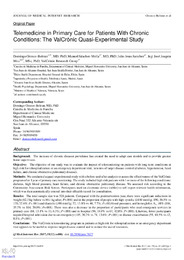Título :
Telemedicine in Primary Care for Patients With Chronic Conditions: The ValCrònic Quasi-Experimental Study |
Autor :
Orozco-Beltran, Domingo 
Sánchez-Molla, Manuel 
Sanchez, Julio Jesus 
Mira, José Joaquín  |
Editor :
JMIR Publications |
Departamento:
Departamentos de la UMH::Medicina Clínica
Departamentos de la UMH::Psicología de la Salud |
Fecha de publicación:
2017-07 |
URI :
https://hdl.handle.net/11000/37958 |
Resumen :
Background: The increase of chronic diseases prevalence has created the need to adapt care models and to provide greater home supervision.
Objective: The objective of our study was to evaluate the impact of telemonitoring on patients with long-term conditions at high risk for rehospitalization or an emergency department visit, in terms of target disease control (diabetes, hypertension, heart failure, and chronic obstructive pulmonary disease).
Methods: We conducted a quasi-experimental study with a before-and-after analysis to assess the effectiveness of the ValCrònic program after 1 year of primary care monitoring. The study included high-risk patients with 1 or more of the following conditions: diabetes, high blood pressure, heart failure, and chronic obstructive pulmonary disease. We assessed risk according to the Community Assessment Risk Screen. Participants used an electronic device (tablet) to self-report relevant health information, which was then automatically entered into their eHealth record for consultation.
Results: The total sample size was 521 patients. Compared with the preintervention year, there were significant reductions in weight (82.3 kg before vs 80.1 kg after; P=.001) and in the proportion of people with high systolic (≥140 mmHg; 190, 36.5% vs 170, 32.6%; P=.001) and diastolic (≥90 mmHg; 72, 13.8% vs 40, 7.7%; P=.01) blood pressures, and hemoglobin A1c ≥8% (186, 35.7% vs 104, 20.0%; P=.001). There was also a decrease in the proportion of participants who used emergency services in primary care (68, 13.1% vs 33, 6.3%; P<.001) and in hospital (98, 18.8% vs 67, 12.8%; P<.001). Likewise, fewer participants required hospital admission due to an emergency (105, 20.2% vs 71, 13.6%; P<.001) or disease exacerbation (55, 10.5% vs 42, 8.1%; P<.001).
Conclusions: The ValCrònic telemonitoring program in patients at high risk for rehospitalization or an emergency department visit appears to be useful to improve target disease control and to reduce the use of resources.
|
Palabras clave/Materias:
chronic disease
primary health care
telemedicine |
Área de conocimiento :
CDU: Ciencias aplicadas: Medicina |
Tipo de documento :
info:eu-repo/semantics/article |
Derechos de acceso:
info:eu-repo/semantics/openAccess
Attribution-NonCommercial-NoDerivatives 4.0 Internacional |
DOI :
https://doi.org/10.2196/jmir.7677 |
Publicado en:
Journal of Medical Internet Research, 19(12), e400 - December 2017 |
Aparece en las colecciones:
Artículos Medicina Clínica
|

 La licencia se describe como: Atribución-NonComercial-NoDerivada 4.0 Internacional.
La licencia se describe como: Atribución-NonComercial-NoDerivada 4.0 Internacional.
.png)